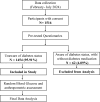Opportunistic random blood glucose screening among professional drivers in northeastern Bangladesh: Assessing undiagnosed diabetes and health awareness
- PMID: 40554480
- PMCID: PMC12186904
- DOI: 10.1371/journal.pgph.0004828
Opportunistic random blood glucose screening among professional drivers in northeastern Bangladesh: Assessing undiagnosed diabetes and health awareness
Abstract
Diabetes remains a silent epidemic in underrepresented high-risk groups like professional drivers, highlighting the urgent need for informed health policies and targeted interventions. This study aimed to assess the prevalence of undiagnosed diabetes and related health awareness among professional drivers in northeastern Bangladesh using opportunistic random blood glucose (RBG) testing to address knowledge gaps and inform health policy. A cross-sectional study was conducted on 1,454 participants enrolled between February 5, 2024 and July 27, 2024, using a consent-based questionnaire, anthropometric measurements, and RBG testing with a glucometer. Diabetes awareness was assessed using pre-tested questionnaires, while the prevalence of diabetes and associated factors were evaluated using Mann-Whitney U tests, Welch ANOVA, and Spearman correlation analysis. A total of 2.20% of the driver population were found to have undiagnosed diabetes. RBG levels differed significantly across regions. Middle age (7.63%) and overweight (3.77%) groups exhibited the highest prevalence of undiagnosed diabetes. Confounding variables such as BMI (r = 0.22, p < 0.0001), age (r = 0.19, p < 0.0001), and sleep duration (r = -0.05, p = 0.04) were significantly associated with glucose levels, indicating potential risk factors for diabetes. The obese group (AOR: 3.04, 95% CI: 0.81-11.46) and overweight group (AOR: 1.81, 95% CI: 0.83-3.99) were 3.04 and 1.81 times more likely, respectively, to develop diabetes compared to the healthy weight group. Participants with less than 7 hours of sleep (AOR: 1.13, 95% CI: 0.46-2.75) were also at greater risk. Co-morbidities and a family history of diabetes were also significantly associated with elevated RBG levels. Overall, this study highlights the regional and behavioral disparities influencing the development of diabetes risk among professional drivers, a population often neglected in health policy. It underscores the need for health education and large-scale RBG testing to improve awareness and alert policymakers in formulating effective health guidelines.
Copyright: © 2025 Arman et al. This is an open access article distributed under the terms of the Creative Commons Attribution License, which permits unrestricted use, distribution, and reproduction in any medium, provided the original author and source are credited.
Conflict of interest statement
The authors have declared that no competing interests exist.
Figures





Similar articles
-
Behavioral interventions to reduce risk for sexual transmission of HIV among men who have sex with men.Cochrane Database Syst Rev. 2008 Jul 16;(3):CD001230. doi: 10.1002/14651858.CD001230.pub2. Cochrane Database Syst Rev. 2008. PMID: 18646068
-
Strategies for enhancing the implementation of school-based policies or practices targeting risk factors for chronic disease.Cochrane Database Syst Rev. 2017 Nov 29;11(11):CD011677. doi: 10.1002/14651858.CD011677.pub2. Cochrane Database Syst Rev. 2017. Update in: Cochrane Database Syst Rev. 2022 Aug 29;8:CD011677. doi: 10.1002/14651858.CD011677.pub3. PMID: 29185627 Free PMC article. Updated.
-
Systemic pharmacological treatments for chronic plaque psoriasis: a network meta-analysis.Cochrane Database Syst Rev. 2017 Dec 22;12(12):CD011535. doi: 10.1002/14651858.CD011535.pub2. Cochrane Database Syst Rev. 2017. Update in: Cochrane Database Syst Rev. 2020 Jan 9;1:CD011535. doi: 10.1002/14651858.CD011535.pub3. PMID: 29271481 Free PMC article. Updated.
-
Intravenous magnesium sulphate and sotalol for prevention of atrial fibrillation after coronary artery bypass surgery: a systematic review and economic evaluation.Health Technol Assess. 2008 Jun;12(28):iii-iv, ix-95. doi: 10.3310/hta12280. Health Technol Assess. 2008. PMID: 18547499
-
Systemic pharmacological treatments for chronic plaque psoriasis: a network meta-analysis.Cochrane Database Syst Rev. 2021 Apr 19;4(4):CD011535. doi: 10.1002/14651858.CD011535.pub4. Cochrane Database Syst Rev. 2021. Update in: Cochrane Database Syst Rev. 2022 May 23;5:CD011535. doi: 10.1002/14651858.CD011535.pub5. PMID: 33871055 Free PMC article. Updated.
References
-
- Hossain MB, Khan MN, Oldroyd JC, Rana J, Magliago DJ, Chowdhury EK, et al. Prevalence of, and risk factors for, diabetes and prediabetes in Bangladesh: evidence from the national survey using a multilevel Poisson regression model with a robust variance. Sarker AR, editor. PLOS Glob Public Health. 2022;2(6):e0000461. doi: 10.1371/journal.pgph.0000461 - DOI - PMC - PubMed
-
- van Niel J, Geelhoed-Duijvestijn PHLM, Numans ME, Kharagjitsing AV, Vos RC. Type 2 diabetes in South Asians compared to Europeans: higher risk and earlier development of major cardiovascular events irrespective of the presence and degree of retinopathy. Results from The HinDu The Hague Diabetes Study. Endocrinol Diabetes Metab. 2021;4(3):e00242. doi: 10.1002/edm2.242 - DOI - PMC - PubMed
LinkOut - more resources
Full Text Sources
